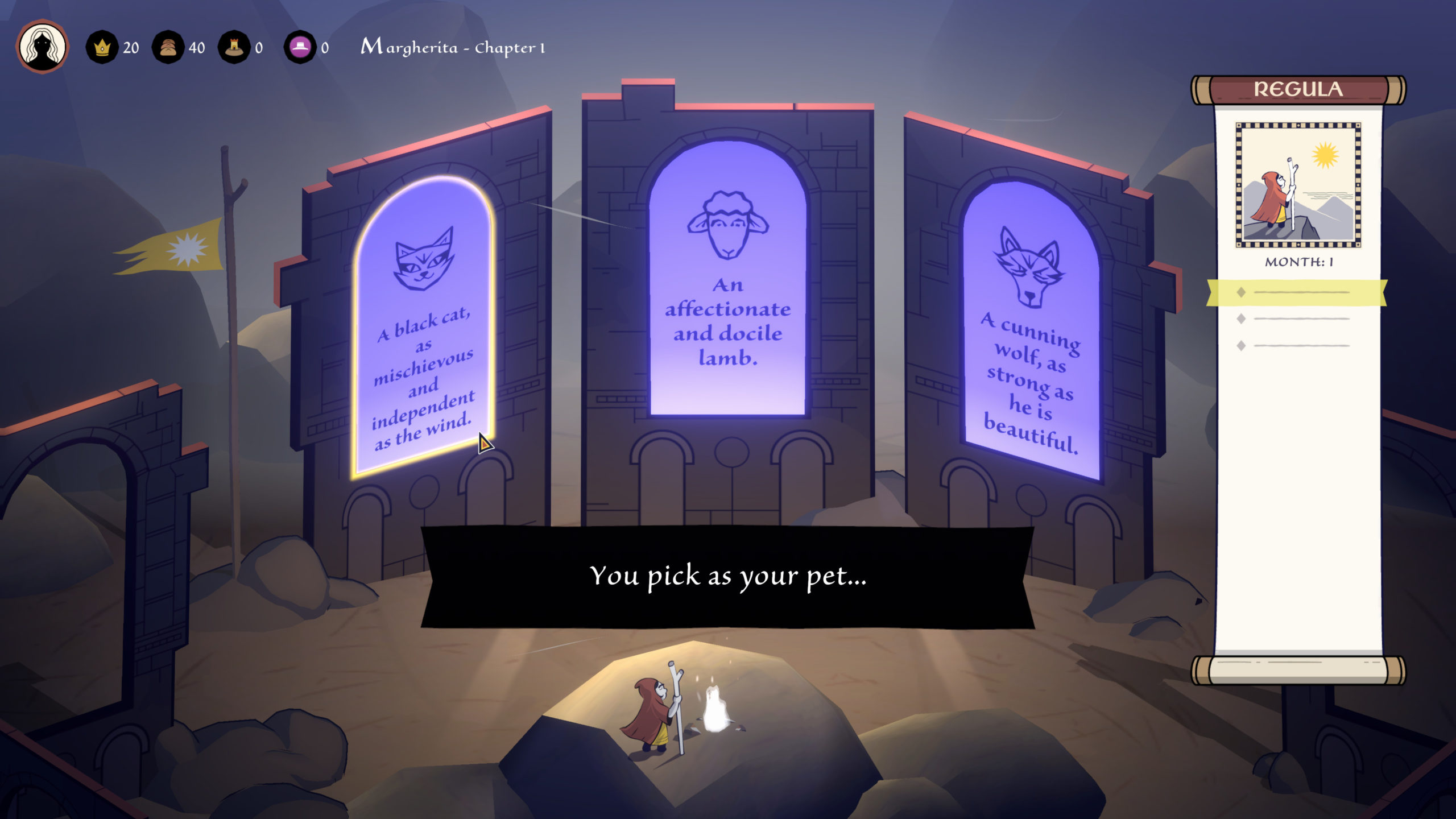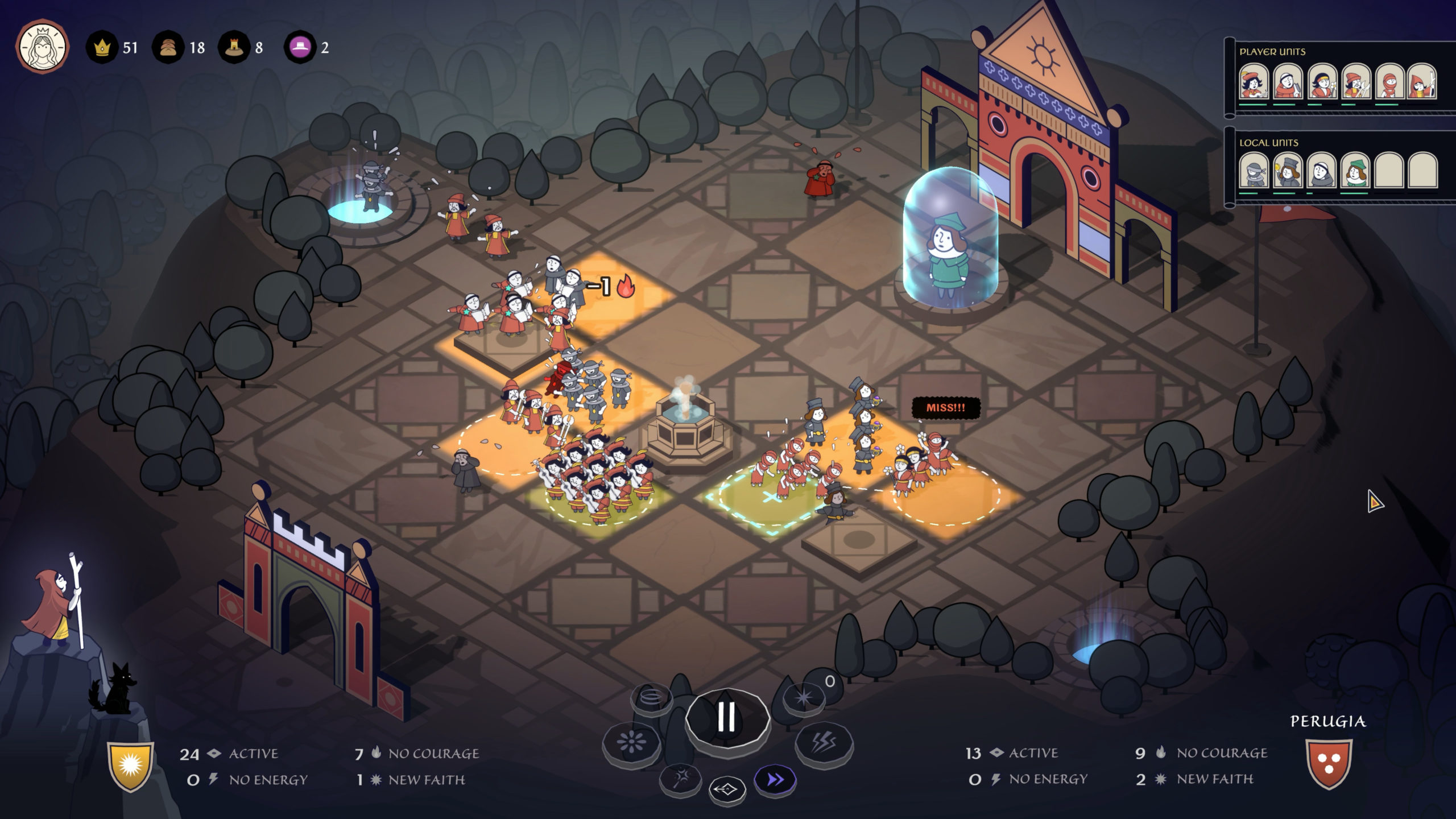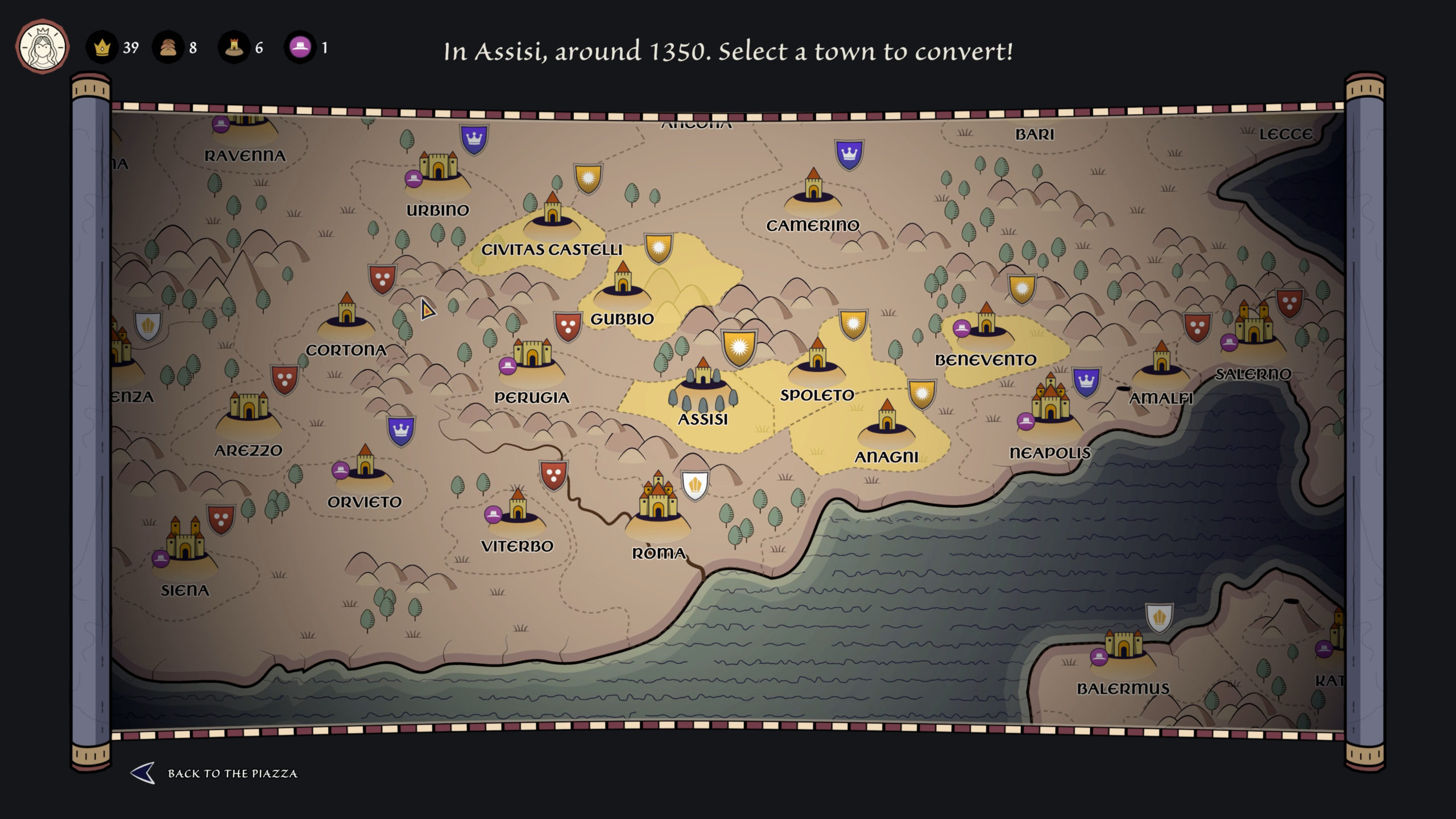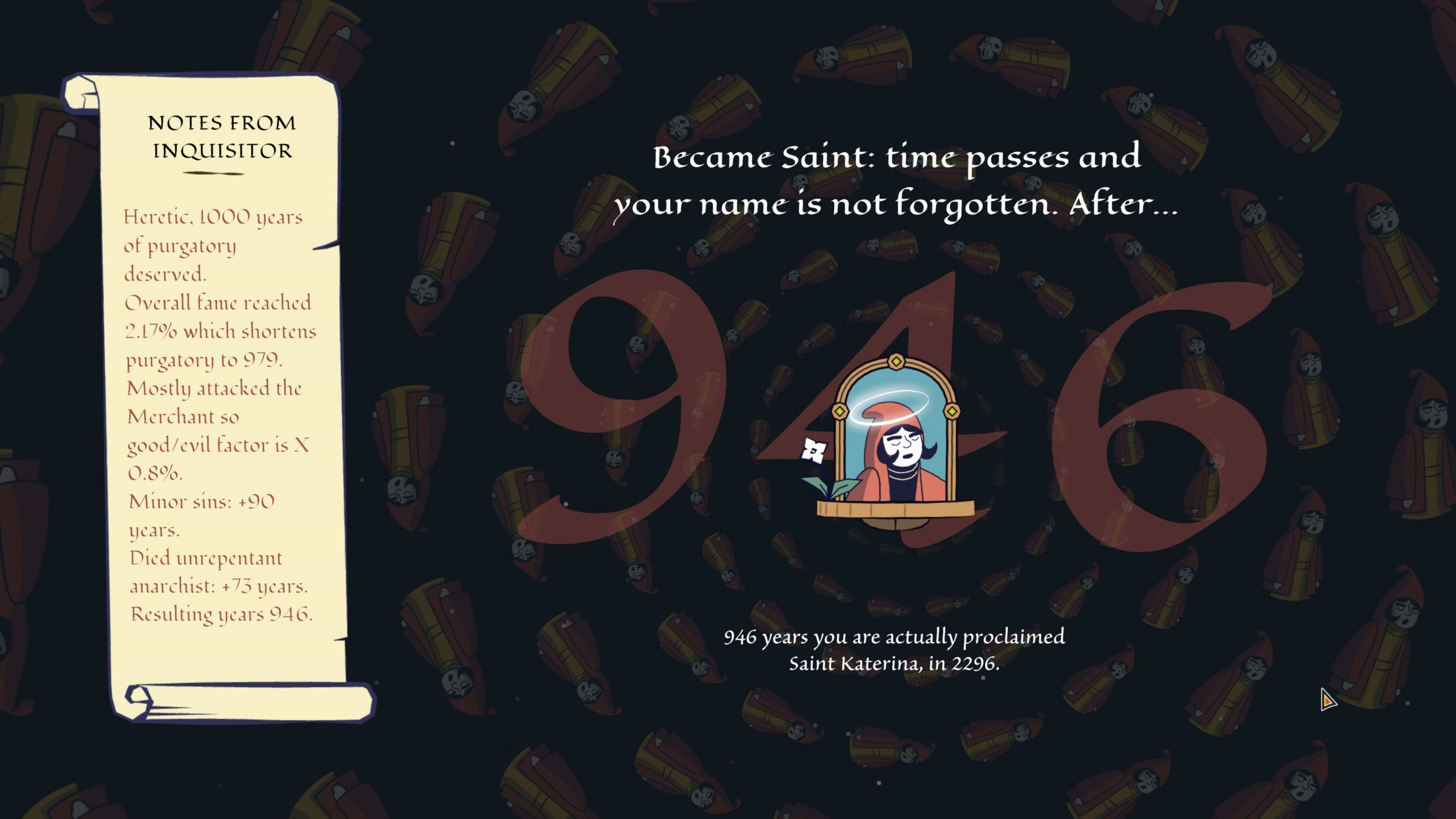Platform:
PC
Released:
July 15, 2025
Publishers:
Firesquid, 2P Games
Developer:
Open Lab Games
Developed by Open Lab Games, Becoming Saint is a real-time strategy roguelike with political simulation elements. Set in 14th-century medieval Italy, Becoming Saint tasks you with converting city-states to your doctrine. Sadly, Becoming Saint’s core gameplay loop is short, repetitive, and bereft of engaging gameplay.
The primary loop of Becoming Saint starts with making choices that define your doctrine, with three questions between each battle that shape your political, economic, and spiritual outlook. Mechanically, these serve the singular purpose of changing the kind of units that you can recruit into your cause. Given that the game posits itself as having elements of political simulation, the shallow nature of these choices is disappointing.
After a successful conversion, you are presented with the three choices and given three options for each. As far as I could tell, the available choices are static. At the start of each run, you are always asked to decide what animal to represent your movement. During my time with the game, I could only choose between a wolf, a sheep, or a cat. Given this, restarting a run felt very repetitive quite quickly.

This is a huge mark against any roguelike. One of the cornerstones of the genre is the ability to differentiate countless runs. While repetition might set in eventually, the best force you to change strategies and approach situations differently. In a great roguelike, each time you start a new run, those initial choices can cascade across the entire attempt. Becoming Saint never required me to change my approach.
Once you’ve made these choices, you recruit followers to march with you to a new city to conquer it. Each of these units taxes one of the two resources you manage: food. During marches, you will choose to feed your followers fully, partially, or not at all. Missing a meal can be devastating for the other major resource, charisma. For most of my playtime, refusing to feed my crusaders would have instantly ended my run by hitting zero charisma.
Along your route, some unit types will beg for food, with their success depending on your doctrine. Similarly, feeding my troops a ‘full meal’ gave such a small bonus to charisma, but would cost a huge amount of food. I was once again stuck with one static choice. My followers always received a meagre meal to retain both the maximum amount of food at no cost to charisma.
Upon reaching your destination, you’ll engage in a small skirmish or confrontation with defenders of the city-state. According to the game, these are ‘non-violent’, although the mechanics do little to indicate that this is the case.

On a 5×6 grid, you’ll arrange your troops and start the battle. Confrontations in Becoming Saint are dead simple, even to the point where there is an ‘autobattler’ option, which moves your followers for you. Otherwise, you can move your followers around, bless your troops, or curse the opposition. Defeated units don’t die and instantly vanish. As this is a ‘non-violent conversion’, they run and spread across the map, which creates a frustrating amount of visual noise that can make it difficult to tell what’s going on with the remaining soldiers.
Some terrain elements give slight bonuses to your troops, but poor tutorialisation of the battle mechanics means this is very opaque. For the most part, each battle feels the same, as you try to gang up your troops on one of the enemies before moving to the next. Different follower types are better against different enemies, but once again, due to poor tutorialisation of this, I never felt it necessary to engage in this strategic layer.
“Very little time playing Becoming Saint is spent actually playing.”
Once you’ve taken over the city, a few things happen. First, you’ll be taxed food if you decide to feed the defeated city-state. If you choose not to, you will instead lose charisma for being cold-hearted. Then, you will gain food for all cities under your rule. Then, you lose food in a large feast where you must feed all your followers.
Just to put this process in perspective, conquering a new city-state predominantly involves watching a counter tracking food go up and down, and a brief battle that lacks any tactical depth. Becoming Saint also revels in wasting your time. There is a lot of downtime between each of these choices. These splash screens of large text play out the same way between every interaction. Very little time playing Becoming Saint is spent actually playing.

You then repeat the process and attempt to march on a new city. Some random events sometimes occur on longer marches. Admittedly, I did not have this occur much as I found the game frustratingly boring. But, with so few gameplay levers to pull, the few I interacted with just served as other ways to lower my food or charisma. Further, there is no randomisation in the map for Becoming Saint. Being based in Italy, each town or location has a static location and power, which does not help when so much of the game already feels rote and repetitive.
I additionally found the difficulty in Becoming Saint to be wildly inconsistent. On multiple runs, the closest city states with the weakest defences would trounce my initial conversion attempt, instantly ending the run. On others, once I had beaten the first location, I never ran into trouble again. It was difficult to parse what separated those initial battles, especially as units seem to ignore commands half the time when in ‘tactician mode’.

There is an ‘easy mode’ available before you start a run, but I couldn’t find what this changed besides giving more food at the start of the game. Beyond this, the options menu is extremely light, and there is a distinct lack of accessibility options as well. Presentation is a stronger element of Becoming Saint. The simplistic music and audio design match well with the cutesy, almost papercraft visuals.
Without any narrative to speak of, the repetition and time wasting seep into the game as a whole, and it is difficult to recommend any aspect of Becoming Saint. Combat is too poorly designed to recommend Becoming Saint’s strategy elements. Management elements are too simplistic to recommend as a management game, and player choice is too limited to recommend it as a political simulation.
4
Mediocre
Positive:
- Visual presentation is unique
Negative:
- Simplistic real-time strategy elements
- Poor tutorialisation
- Management that boils down to two numbers
- Very little in terms of actual gameplay elements
Becoming Saint is a dull way to spend your time. While the pitch is intriguing and the visual presentation is neat, there is almost nothing here worth engaging with on a mechanical level. For a roguelike, that complete lack of narrative depth quickly gives way to an uninteresting and repetitive gameplay loop.





